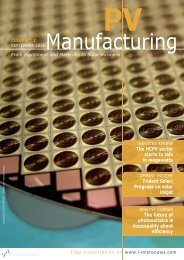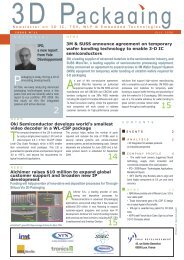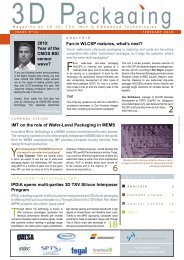Inertial Combo Sensors in Consumer and Automotive - I-Micronews
Inertial Combo Sensors in Consumer and Automotive - I-Micronews
Inertial Combo Sensors in Consumer and Automotive - I-Micronews
Create successful ePaper yourself
Turn your PDF publications into a flip-book with our unique Google optimized e-Paper software.
Executive summary<br />
Complexity of sensor fusion<br />
• One clear motivation for combo sensors is the possibility to reduce both cost <strong>and</strong> footpr<strong>in</strong>t by comb<strong>in</strong><strong>in</strong>g the<br />
two sensors <strong>in</strong>to one package with a s<strong>in</strong>gle ASIC<br />
– However this cost benefit is not yet obvious with the dynamism of the evolution of each <strong>in</strong>dividual sensor. Such benefit will be<br />
very application dependent<br />
– Lower cost units comb<strong>in</strong><strong>in</strong>g multiple MEMS sensors are poised for healthy growth, start<strong>in</strong>g with ESCs, br<strong>in</strong>g<strong>in</strong>g opportunity for<br />
new players <strong>and</strong> dem<strong>and</strong>s for sensor management solutions. This trend is show<strong>in</strong>g up first <strong>in</strong> the more mature automotive<br />
MEMS sector, where the price of the sensor unit for the electronic stability control system (ESC) can now be significantly<br />
reduced, by comb<strong>in</strong><strong>in</strong>g the accelerometer <strong>and</strong> the gyroscope <strong>in</strong> one package with one ASIC<br />
– Adoption is a little slower on the consumer side, where the fast chang<strong>in</strong>g technology means discrete device prices are still<br />
fall<strong>in</strong>g rapidly, so products from even six months before have less of a cost advantage. But the consumer market’s fast model<br />
turnover <strong>and</strong> short replacement cycles means that once the economics become compell<strong>in</strong>g <strong>and</strong> adoption starts <strong>in</strong> 2012 – 2013,<br />
market penetration will be faster <strong>and</strong> deeper than on the automotive side.<br />
• The second key motivation from combo sensors relies on sensor fusion<br />
– New functionality can now be offered us<strong>in</strong>g multiple sens<strong>in</strong>g elements<br />
– We see a strong evolution from sensors to solutions<br />
– This is an opportunity for players <strong>in</strong> the MEMS <strong>in</strong>dustry to compensate for the drastic decrease <strong>in</strong> price by sell<strong>in</strong>g high value<br />
solutions that <strong>in</strong>clude more software content<br />
• Who will capture the added value of these smart sensor systems?<br />
• There is likely room for multiple alternatives, with the sensor makers supply<strong>in</strong>g the algorithms to comb<strong>in</strong>e <strong>and</strong> cross-calibrate the<br />
sensor data <strong>and</strong> do some st<strong>and</strong>ard applications, while the software <strong>and</strong> chipset makers supply the higher level, specialty functions<br />
– <strong>Combo</strong> sensors require more complex software for the sensor fusion calculations, <strong>and</strong> those will likely need to be done on an<br />
MCU, not just the usual ASIC<br />
• This is driv<strong>in</strong>g changes <strong>in</strong> the supply cha<strong>in</strong>, as makers of microcontrollers, software, <strong>and</strong> subsystems start to take over more of the<br />
sensor management.<br />
© 2011• 5<br />
2011 Copyrights © Yole Développement SA. All right reserved.

















